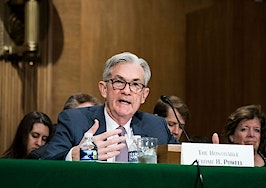Mortgage rates rose for the first time in weeks, with 30-year loans returning to roughly the levels they had held in mid-July, according to Freddie Mac’s weekly lender survey

Sam Khater | Photo credit: Freddie Mac
“Following last Friday’s strong jobs report, which revealed broad based gains in employment and wage growth, mortgage rates are moving higher,” Freddie Mac Chief Economist Sam Khater said in a news release. “After dropping for six consecutive weeks, the 30-year fixed-rate mortgage increased by ten basis points week over week. Despite the rise, rates remain very low, particularly given that economic growth is strong and will continue into next year.”
For the week ending Aug. 12, Freddie Mac’s weekly Primary Mortgage Market Survey reported average rates for the following types of loans:
- For 30-year fixed-rate mortgages, rates averaged 2.87 percent with an average 0.7 point, up from 2.77 percent last week but still lower than 2.96 percent a year ago. Rates for 30-year loans hit an all-time low of 2.65 percent during the week ending Jan. 7, 2021, according to records dating to 1971.
- Rates on 15-year fixed-rate mortgages averaged 2.15 percent with an average 0.7 point, rising from last week’s historic low of 2.10 percent and down from a rate of 2.46 percent a year ago. The mark kept rates for 15-year fixed rate mortgage loans near the all-time lowof 2.10 percent set the week ending Aug. 5, 2021, according to records dating to 1991.
- For 5-year Treasury-indexed hybrid adjustable-rate mortgage (ARM) loans, rates averaged 2.44 percent with an average 0.3 point, up from 2.40 percent last week and down from 2.90 percent a year ago. Rates on 5-year ARM loans are still near their lowest levels since at least 2005, resting just above its lowest point of 2.40 percent during the week ending Aug. 5, 2021.
Freddie Mac’s weekly survey of home purchase loans assumes borrowers have excellent credit and are able to put 20 percent down on a home. Borrowers with lower credit scores or making smaller down payments can expect higher interest rates.
Rates have come down since February and March, when inflation-related concerns drove them temporarily higher for borrowers. Since then, however, rates for 30-year loans have remained around or below 3 percent.
During the pandemic, the Federal Reserve has been keeping a lid on interest rates by increasing its holdings of long-term Treasurys and mortgage-backed securities (MBS) by $120 billion a month. Before announcing a timetable for tapering those purchases, Federal Reserve Chairman Jerome Powell has said he would want to see “strong job numbers.”












